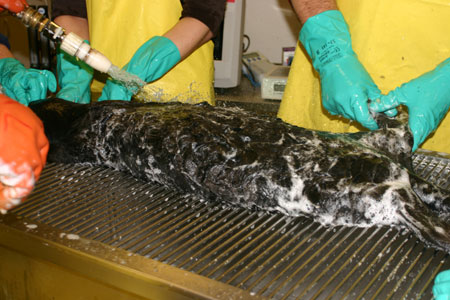 A sea otter undergoing the washing process.
A sea otter undergoing the washing process.
The Exxon Valdez Oil Spill (EVOS) in 1989 illuminated many areas for improvement when caring for oil-affected wildlife in general, and sea otters in particular. In response to the need for improved methods of washing sea otters, CDFW Senior Wildlife Veterinarian Dave Jessup spearheaded a study at the MWVCRC that explored impacts of different water types on recovery times of washed sea otters. The goals of this study were to reduce rehabilitation time of oiled sea otters, and to improve oiled sea otter care protocols for California.
From 2004 to 2008, Jessup and research staff at the MWVCRC experimentally washed captive sea otters, manipulating water temperature and salinity in the recovery pools. They measured the effect of these treatments on the time it took for sea otters to recover from washing, as indicated by the time it took to 1) restore water repellency of their fur (assessed visually and using a thermal camera), 2) regain “normal” (pre-wash) body temperature (core and subcutaneous), and 3) to exhibit “normal” behaviors, as assessed by trainers. Assessment of subcutaneous body temperature using temperature-sensitive passive integrative transponder (PIT) tags, and assessment of coat condition using thermography represent the use of two new technologies for the care of oil-affected animals. PIT tags are about the size of a grain of rice and were injected under the skin to provide body temperature readings near the surface of the otters. Thermography is the use of an infrared camera to visualize heat loss, which helps identify areas of poor water repellency in sea otters.
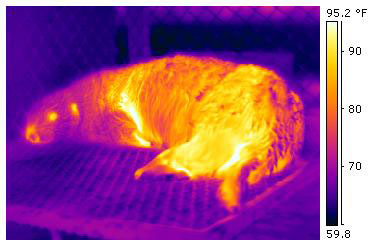 A thermograph of a sea otter.
A thermograph of a sea otter.
The results of the study indicated that otters allowed to recover in softened freshwater pools recovered faster (average 2 day recovery), compared to freshwater pools (average of 7 day recovery). Warming the soft fresh water provided some benefit to the captive otters, which were in good physical condition. Subcutaneous body temperatures returned to pre-wash (“normal”) values more quickly than core body temperature for all treatments. Thermography proved useful for assessing fur condition (water repellency) for all treatments.
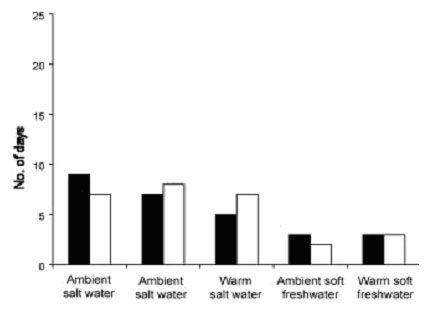 A graph showing the changes in an otters recovery time when exposed to various recovery pool conditions.
A graph showing the changes in an otters recovery time when exposed to various recovery pool conditions.
Recovery times (days) of sea otters that were exposed to different water temperatures and salinities in recovery pools after washing. See the full results of the study.
The results of this study have implications for improving care of oiled sea otters in California and throughout the sea otter’s range. First, using softened freshwater instead of saltwater during the initial recovery phase after washing can significantly improve recovery times of oiled sea otters. Second, the finding that subcutaneous temperatures return to normal more quickly than core body temperatures underscores the importance of using internal thermal transmitters to assess core body temperature to assess recovery status. Finally, the use of infrared thermography can help identify heat loss in areas of poor water repellency so rehabilitators can more accurately assess coat condition and evaluate the necessity of re-washing or otherwise altering the treatment plan to promote waterproofing. The findings outlined above will be incorporated in updated oiled sea otter rehabilitation protocols for California, and may be adopted by other states where sea otters reside.
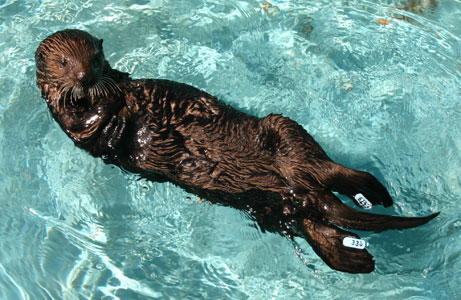 A sea otter resting in a pool during post-wash recovery.
A sea otter resting in a pool during post-wash recovery.
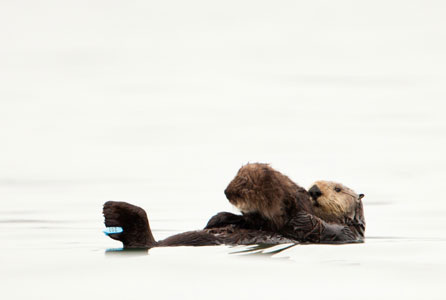 An oiled otter that had been washed, rehabilitated, and released is later seen holding her first pup.
An oiled otter that had been washed, rehabilitated, and released is later seen holding her first pup.
These new recommendations were put to the test on February 21, 2009, when an oiled, sub-adult, female sea otter stranded on Sunset Beach, Santa Cruz, CA. “Olive” received first-class care at the MWVCRC, and was the first wild oiled sea otter to be rehabilitated according to the new procedures. In Olive’s case, warming the softened freshwater in her recovery pool was vital to her rehabilitation, as she had poor body condition and had a hard time staying warm enough on her own. She fully recovered and was released back into the wild in April 2009, sporting new flipper tags and an internal radio transmitter that helps biologist track her. Olive was seen with her first pup on September 7, 2012. She will continue to be tracked to monitor her health and reproductive status. For the latest update on Olive, please visit her Facebook page.
Olive offered a great opportunity to test MWVCRC equipment and personnel readiness, as this facility was designed to be the primary care facility for oiled sea otters in California.